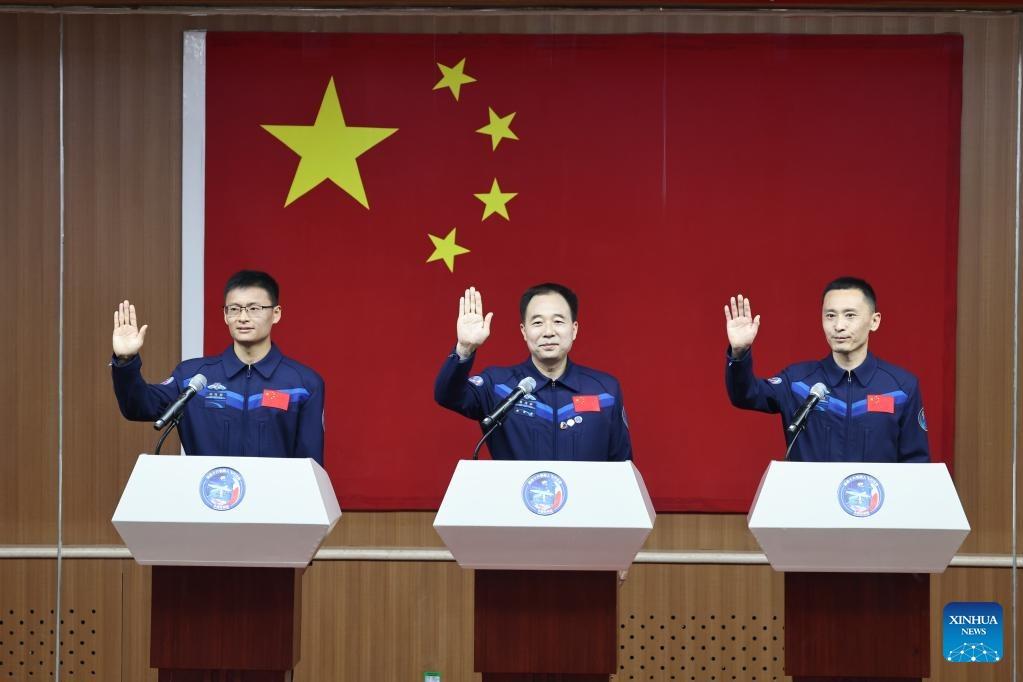 Chinese taikonauts Jing Haipeng (center), Zhu Yangzhu (right) and Gui Haichao wave to journalists at the Jiuquan Satellite Launch Center in northwest China May 29, 2023. (PHOTO / XINHUA)
Chinese taikonauts Jing Haipeng (center), Zhu Yangzhu (right) and Gui Haichao wave to journalists at the Jiuquan Satellite Launch Center in northwest China May 29, 2023. (PHOTO / XINHUA)
The Shenzhou XVI crewed spaceship is scheduled to be launched at 9:31 am Tuesday (Beijing Time) from the Jiuquan Satellite Launch Center in northwest China.
Chinese taikonauts Jing Haipeng, Zhu Yangzhu, and Gui Haichao will carry out the spaceflight mission, and Jing will be the commander, the China Manned Space Agency (CMSA) announced at a press conference on Monday.
Jing, a senior spacecraft pilot, will become the country's first taikonaut to go into space for the fourth time. He was involved in the Shenzhou VII mission in 2008 and commanded the Shenzhou IX and Shenzhou XI crews in 2012 and 2016, respectively.
Zhu and Gui are set to embark on their first trip to space. Born in 1986, they are members of China's third batch of taikonauts, whose selection was completed by September 2020.
Jing Haipeng, Zhu Yangzhu and Gui Haichao will carry out the Shenzhou XVI spaceflight mission, and Jing will be the commander, the China Manned Space Agency announced at a press conference on Monday
Zhu, a postdoctoral fellow in aerodynamics and a former university teacher, will serve as a spaceflight engineer in the Shenzhou XVI mission. He will work with commander Jing to control and manage the spacecraft, and conduct technical tests.
He said he is lucky to catch up with a new era, in which everyone who works hard has the opportunity to realize his dreams and values in life.
"Over the past two years, I have grown from an ordinary university teacher to a spaceflight soldier, which is the achievement of my career and the nurturing of the time," said Zhu when the trio met the press on Monday.
Gui, a civilian taikonaut and a spectacled professor at Beijing-based Beihang University, will work as a payload expert responsible for the in-orbit operations of science experiment payloads in China's Tiangong space station.
In addition, Jing and Zhu are members of the People's Liberation Army's Astronaut Division. All of the three crew members hold a doctorate.
Compared to previous crews, the Shenzhou XVI comprises a diverse trio of male astronauts from different career backgrounds, including aircraft pilot, flight engineer and payload specialist.
"This is the first crewed mission with the participation of three types of taikonauts," Lin Xiqiang, deputy director of the CMSA, said at the press conference.
Although the fresh crew has a 20-year age gap, the three have worked together very well.
"We have gotten along like a family," Jing told the press.
According to the CMSA, among China's third batch of taikonauts, seven are spacecraft pilots, seven are flight engineers and four are payload experts. After more than two years of rigorous training, they have become capable of performing spaceflight tasks.
"All of them have started targeted training for the space station in the new stage and will become the backbones of the follow-up missions," Lin said, adding that more new members will be selected to be space travelers in the future.
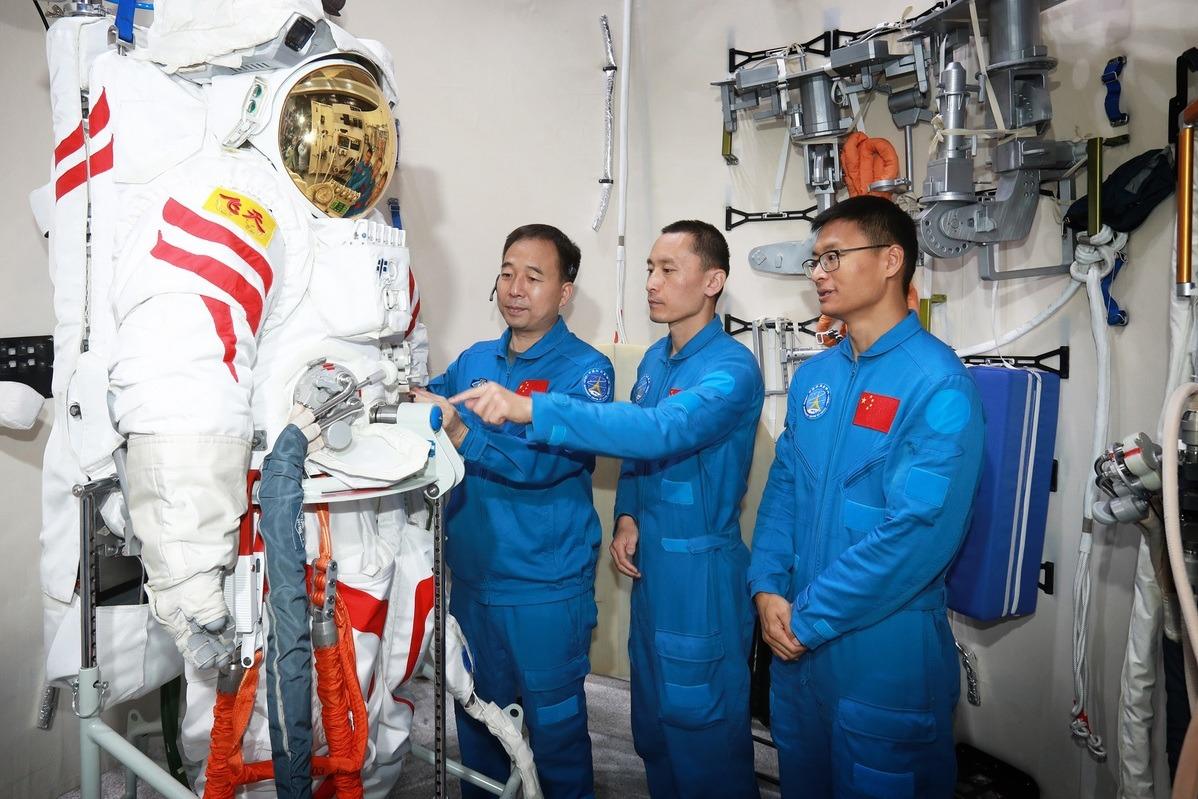 In this undated file photo, Jing Haipeng (left), Zhu Yangzhu (center) and Gui Haichao, three astronauts of China's Shenzhou XVI mission, receive training. (PHOTO BY XU BU / CHINA DAILY)
In this undated file photo, Jing Haipeng (left), Zhu Yangzhu (center) and Gui Haichao, three astronauts of China's Shenzhou XVI mission, receive training. (PHOTO BY XU BU / CHINA DAILY)
'Crew in good condition'
Shenzhou XVI is the second flight mission of China's manned space program this year, and the first crewed mission after China's space station entered the application and development stage.
After the Shenzhou XVI spacecraft enters the orbit, it will activate the rapid rendezvous-docking mode to approach and connect with the radial port on the Tianhe core module, forming a combination with three modules and three spacecraft, Lin said.
ALSO READ: Crew ready for launch of China's Shenzhou XV mission
Jing's team will take over the Tiangong space station from their peers in the Shenzhou XV, mission commander Major General Fei Junlong, Senior Colonel Deng Qingming and Senior Colonel Zhang Lu, who arrived on Nov 30. By now, Fei's crew has stayed in orbit for six months.
The Shenzhou XVI astronauts will witness the dockings of the Tianzhou V cargo craft and the Shenzhou VII crewed spaceship, as well as the departures of the Shenzhou XV manned spaceship and Tianzhou V, Lin said.
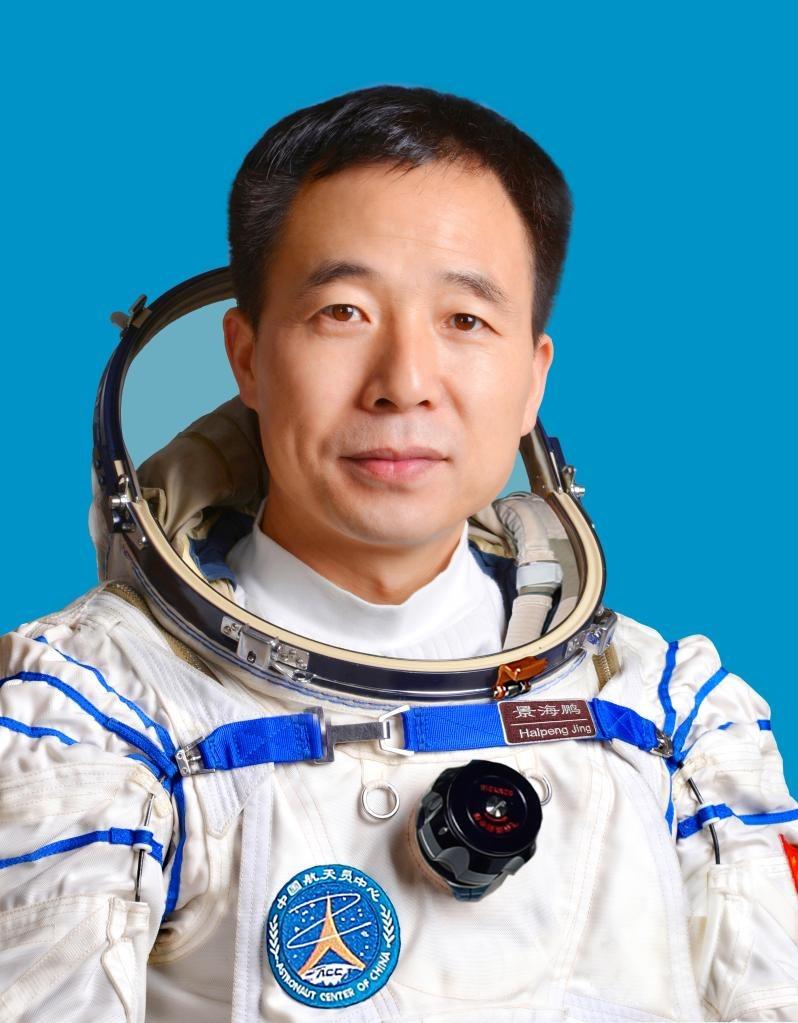 This undated photo shows Jing Haipeng, the commander of the Shenzhou XVI spaceflight mission. (PHOTO / XINHUA)
This undated photo shows Jing Haipeng, the commander of the Shenzhou XVI spaceflight mission. (PHOTO / XINHUA)
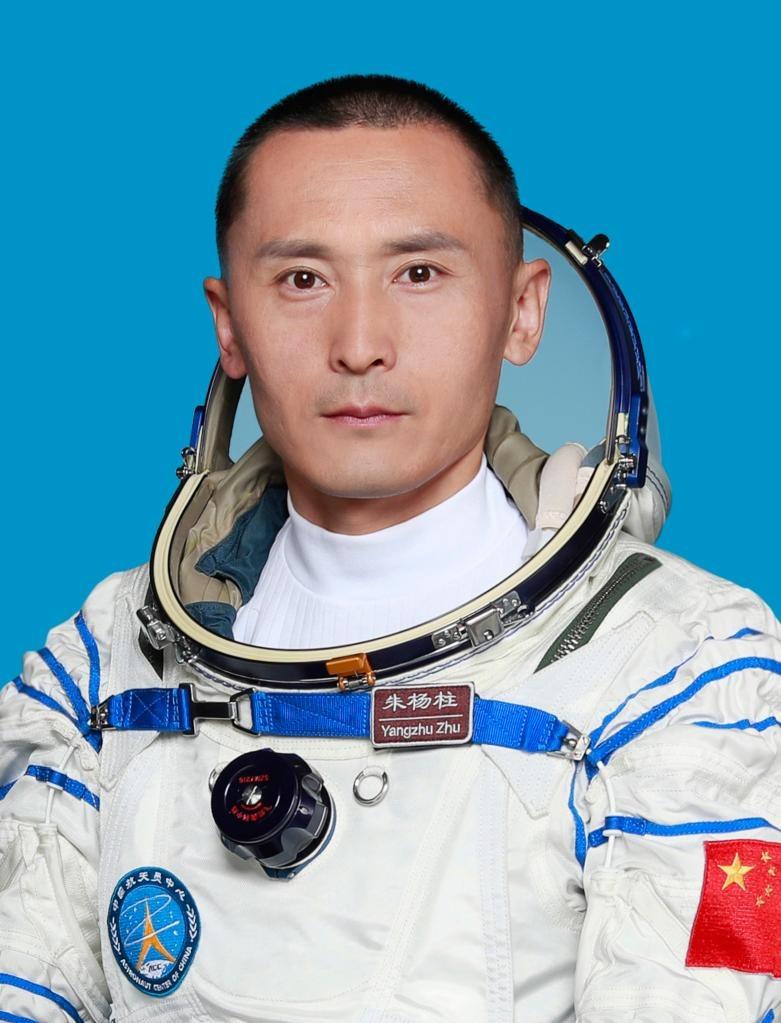 This undated photo shows Zhu Yangzhu, one of the three taikonauts who will carry out the Shenzhou XVI spaceflight mission. (PHOTO / XINHUA)
This undated photo shows Zhu Yangzhu, one of the three taikonauts who will carry out the Shenzhou XVI spaceflight mission. (PHOTO / XINHUA)
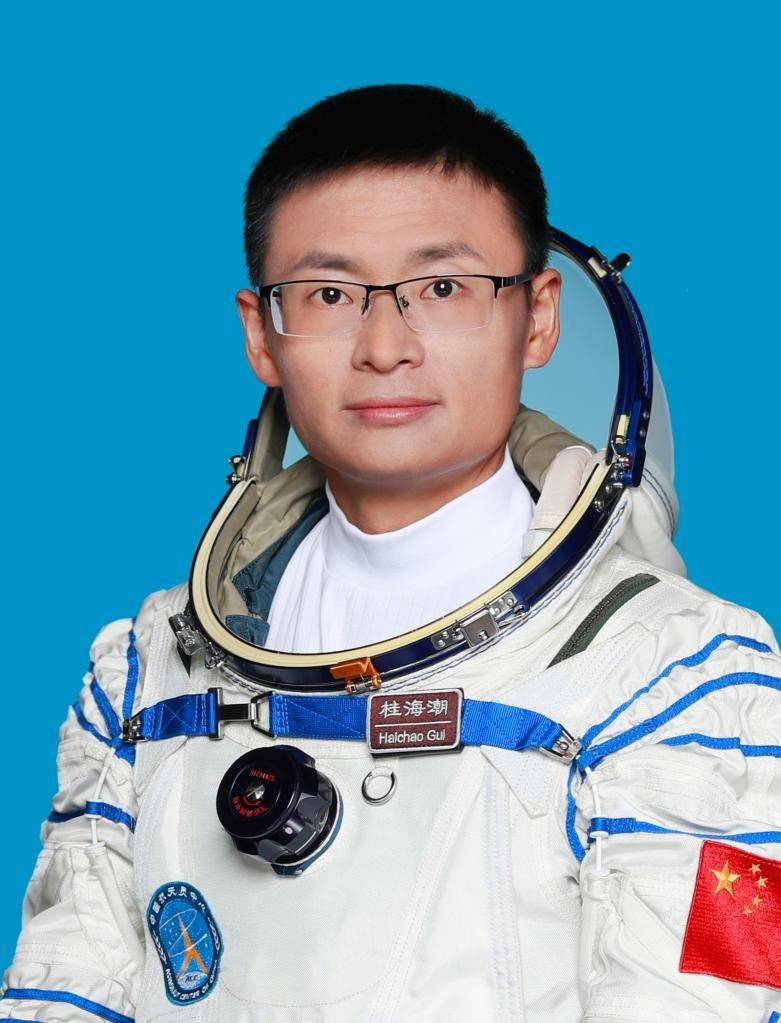 This undated photo shows Gui Haichao, one of the three taikonauts who will carry out the Shenzhou XVI spaceflight mission. (PHOTO / XINHUA)
This undated photo shows Gui Haichao, one of the three taikonauts who will carry out the Shenzhou XVI spaceflight mission. (PHOTO / XINHUA)
The astronauts will conduct large-scale in-orbit tests and experiments in various fields as planned, he said.
They are expected to make high-level scientific achievements in the study of novel quantum phenomena, high-precision space time-frequency systems, the verification of general relativity, and the origin of life, said the official.
ALSO READ: China to realize manned lunar landing by 2030
The Shenzhou XVI mission will also install electric propulsion cylinders and lift extravehicular cameras, he said.
The official added that the mission will carry out several spacewalks to maintain the massive orbital outpost and complete the installation of large extravehicular application facilities such as radiation biological exposure experiment equipment.
The Shenzhou XVI crew is in good condition, while the ground system facilities are in stable operation, Lin said.
The trio will stay in orbit for about five months and is scheduled to return to the Dongfeng landing site in north China's Inner Mongolia autonomous region in November this year, the official said.
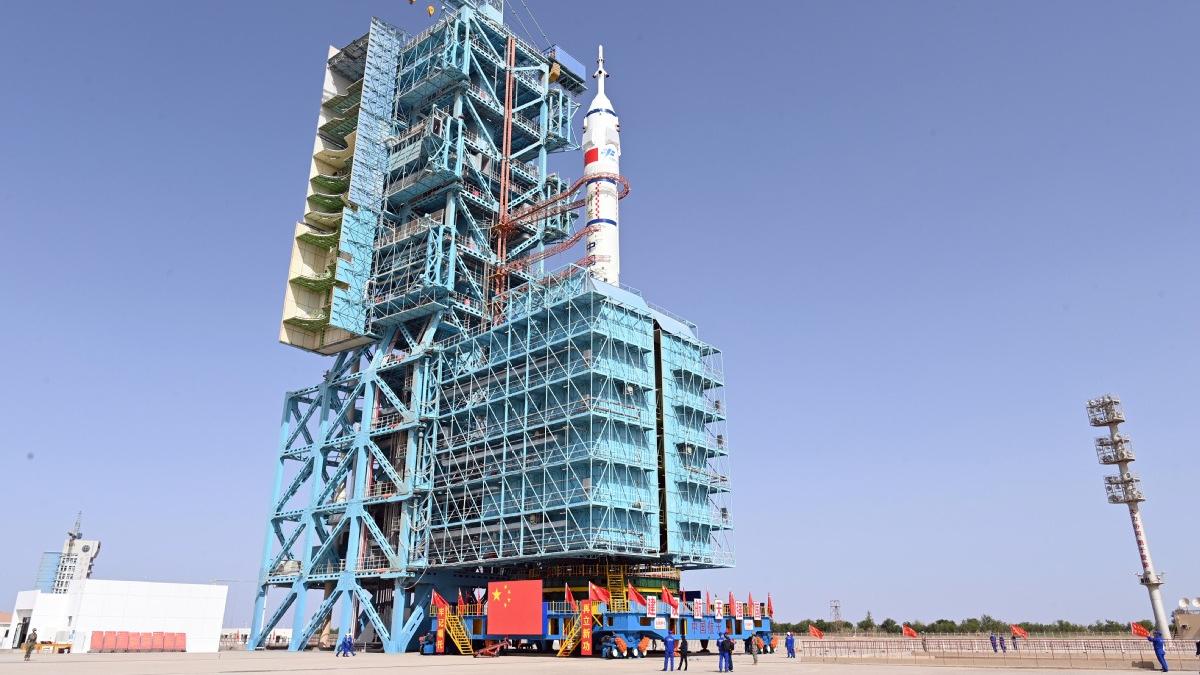 A photo taken on May 22, 2023 shows China's Shenzhou XVI manned spacecraft and a Long March 2F Y16 rocket being transferred to the launch area at the Jiuquan Satellite Launch Center in northwestern China's Gobi Desert. (PHOTO BY WANG JIANGBO / FOR CHINADAILY.COM.CN)
A photo taken on May 22, 2023 shows China's Shenzhou XVI manned spacecraft and a Long March 2F Y16 rocket being transferred to the launch area at the Jiuquan Satellite Launch Center in northwestern China's Gobi Desert. (PHOTO BY WANG JIANGBO / FOR CHINADAILY.COM.CN)
Six categories of in-orbit work
Work handovers of different groups of astronauts and cargo supply missions will be implemented regularly in following missions. According to Lin, the in-orbit work of astronauts mainly covers six categories.
The first is to operate the dockings and returns of crewed spaceships and assist the dockings and departures of cargo craft and survey telescopes, ensuring the regular personnel rotation and material supply.
The second is the maintenance of the space station complex, including the spacecraft status setting, in-orbit material management, platform equipment maintenance and inspection, equipment installation inside and outside the modules, and payload entry into and exit from the modules.
ALSO READ: China plans defense mission against near-Earth asteroids
The third is health management of astronauts, including health status monitoring and in-orbit exercise and training.
The fourth is to conduct large-scale in-orbit scientific research and applications.
Lin said the Shenzhou XVI mission will carry out several spacewalks to maintain the massive orbital outpost and complete the installation of large extravehicular application facilities such as radiation biological exposure experiment equipment
The fifth is the popularization of science, such as giving space lectures and shooting videos for public service.
The sixth is to handle emergent in-orbit failures, fix and replace faulty equipment, and conduct extravehicular maintenance when necessary, so as to ensure long-term stable operation of the space station.
Ready for launch
All preparations for the launch have been completed, CMSA's Lin said.
On Sunday, the Shenzhou XVI mission completed a final pre-launch rehearsal at the launch center.
The vessel, along with its Long March 2F rocket, and all systems and preparations at the launch center are ready for the launch, said the launch center.
The carrier rocket would be filled with propellants at the service tower soon, Lin said.
ALSO READ: Shenzhou XVI is ready for launch
Various inspections of the rocket and the spacecraft and pre-launch rehearsals have been conducted since the combination of the spaceship and the rocket transferred to the launch center, said He Pengju, a senior engineer at the launch center.
He added that the preparations include sealing facilities on the launch tower to prevent sand and rainwater from entering the rocket. It is in accordance with the sandy environment of the Gobi Desert, where the launch center is located.
Foreign astronauts welcomed
China is also looking forward to and welcomes the participation of foreign astronauts in the country's space station flight missions, Lin said.
During the development and construction of China's space station, the country has carried out various forms of exchanges and cooperation with many foreign space agencies and international organizations.
"On the one hand, China is steadily pushing forward the planned cooperation projects with the United Nations Office for Outer Space Affairs, the European Space Agency and other organizations. On the other hand, China has actively expanded exchanges with emerging space nations, focusing on in-orbit scientific experiments and applications, and joint flights for astronauts to the space station," Lin said.
In addition, China has been actively engaged in discussions and the making of regulations pertaining to issues like space environment governance, space traffic management, and the development and utilization of space resources. These efforts have contributed to addressing common challenges of humankind in outer space, the CMSA spokesperson said.
ALSO READ: Chinese astronauts interact with youths from SCO countries
With a complete near-Earth manned space station, a manned shuttle transportation system, and a comprehensive framework for selecting, training and supporting taikonauts, China is now able to carry out crewed missions on a regular basis with a frequency of twice a year.
 A press conference on the Shenzhou XVI mission is held in Jiuquan Satellite Launch Center in northwest China on May 29, 2023. (PHOTO / XINHUA)
A press conference on the Shenzhou XVI mission is held in Jiuquan Satellite Launch Center in northwest China on May 29, 2023. (PHOTO / XINHUA)
As of now, all of the Chinese astronauts who have been on spaceflights are members of the People's Liberation Army. They are the first two generations of astronauts who were selected from experienced Air Force aviators.
The third generation of astronauts has civilians recruited from researchers and engineers.
There are 17 men and one woman in this generation in three groups: seven spacecraft pilots, another seven as spaceflight engineers and the last four as science payloads specialists.
Earlier this month, the Tianzhou VI robotic cargo spaceship set out from the Wenchang Space Launch Center in Hainan province to transport materials for the next manned missions, becoming the first spacecraft to visit the Tiangong space station this year.
READ MORE: Spacewalks become 'routine' after 12th mission
Orbiting about 400 kilometers above the ground, the Tiangong currently consists of three major components, the Tianhe core module and Wentian and Mengtian science lab modules, and is connected with two visiting craft, the Shenzhou XV crew ship and the Tianzhou VI cargo ship.
With Xinhua's inputs



